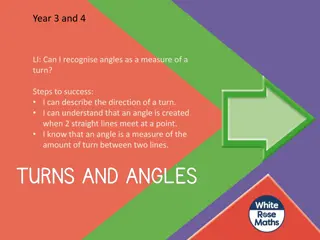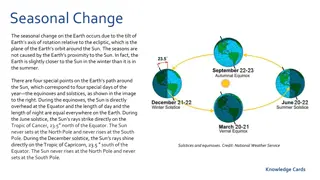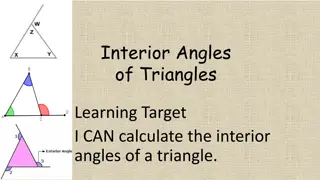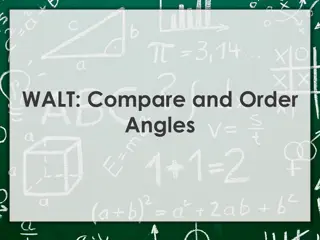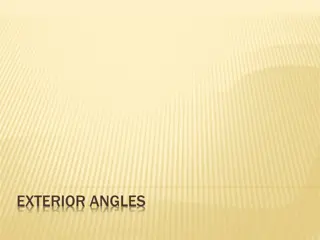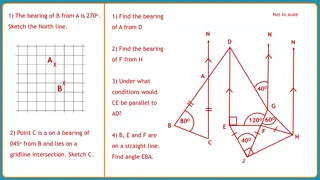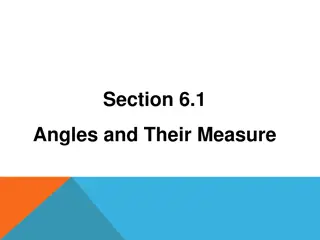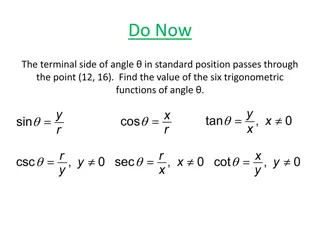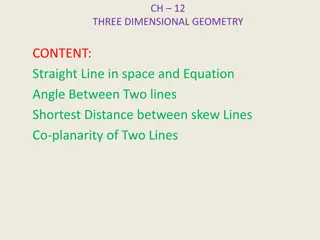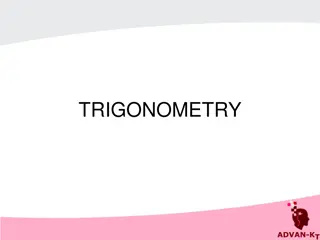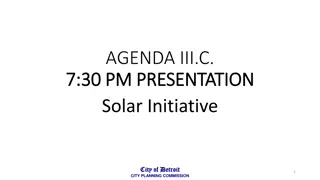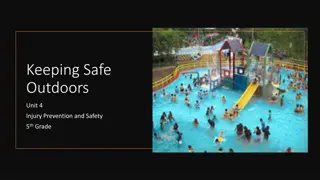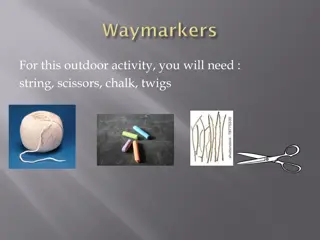Exploring Solar Angles Through Outdoor Activities
Explore the angle of elevation of the sun through outdoor activities involving measuring shadows, determining heights of objects, and observing the sun's position at different times of the day. Students engage in hands-on learning by measuring angles, shadows, and heights to understand concepts of trigonometry in real-life scenarios.
Download Presentation

Please find below an Image/Link to download the presentation.
The content on the website is provided AS IS for your information and personal use only. It may not be sold, licensed, or shared on other websites without obtaining consent from the author. Download presentation by click this link. If you encounter any issues during the download, it is possible that the publisher has removed the file from their server.
E N D
Presentation Transcript
We are going to find the angle of elevation of the sun. OUTSIDE Fill in Student Activity 1A
Student Activity 1A Show the angle of elevation of the sun on the above diagram. Call it A. Describe the angle of elevation of the sun in terms of the two arms of the angle. ___________________________________________________________________ ___________________________________________________________________ ___________________________________________________________________ ___________________________________________________________________ Measure the height of one of the students in your group and the length of their shadow. Height of the student: __________cm. Length of the shadow ____________cm. Draw a rough sketch of a right-angled triangle to model the situation and write in the measurements.
Student Activity 1B Measure the length of the shadow of some tall object e.g. flagpole or goalpost. Length of the shadow of a tall object which you cannot physically measure e.g. goalpost ______________________________cm
Student Activity 1C Back in class Measuring the angle of elevation of the sun Decide what scale to use. Draw an accurate diagram on graph paper. Diagram 1 Measure the angle of elevation of the sun from Diagram 1 above using a protractor. Angle of elevation of the sun at _________ (time) on _______ (date) was _____. Check your answer with other students in the class. If you were to measure the angle of elevation of the sun at 10 a. m and another class measured the angle at 11 a.m. what would be the difference in the measurements?_______________________________
Student Activity 1D Knowing the angle of elevation of the sun, measure the height of a tall object using the length of its shadow as previously measured. Decide what scale to use. Scale: ______________________ Draw an accurate diagram on graph paper using the length of the shadow, the angle of elevation of the sun and forming right-angled triangle (ASA).
Diagram 2 Measure the height of the goalpost from Diagram 2 above and using the scale factor convert to its actual height. Check the answer with other students in the class. Conclusion for part 2: The height of the goalpost is ___________________cm approximately. Would you expect the same answer if you took the measurements at different times of the day? Explain your answer. ________________________________________________________________ ________________________________________________________________ ________________________________________________________________
Student Activity 1E Using Similar Triangles Using graph paper draw the above 2 diagrams overlapping, with the angles of elevation of the sun superimposed as shown by example in the diagram on the right. Label the diagram on the graph paper as in the diagram on the right.
What do you notice about the 2 vertical lines in the triangles? ______________________________________________________________ ______________________________________________________________ |ED| |CB|= Measure the heights of the 2 vertical lines |ED| and |CB|. Measure the 2 horizontal lines |AB| and |AD|. |AB| |AD|= What do you notice about the two ratios? ______________________________________________________________ ______________________________________________________________ ______________________________________________________________ Knowing |AB| and |CB| and the distance |AD| how could you find |ED| without knowing the angle of elevation | EAD| of the sun?
Ratios in Similar Triangles Draw 3 different right angled triangles with the arms of the 90 degree angle being vertical and horizontal line segments, using the same angle of elevation which you calculated for the sun. Call the triangles T1, T2, T3.
Measure the length of the vertical and horizontal line segments in these triangles What do you notice about the ratios of any 2 vertical line segments of any 2 of these triangles and the ratio of the corresponding horizontal line segments?_ __________________________________________________________________ __________________________________________________________________ __________________________________________________________________ __________________________________________________________________ __________________________________________________________________
Student Activity 2 Labelling Sides in Right Angled Triangles What is the hypotenuse of a right-angled triangle? Mark the hypotenuse on the triangles in Student Activity 2 of right-angled triangles. How many other angles are in the triangle? How many degrees do they add up to? What are these angles called?
Student Activity 2 Labelling Sides in Right Angled Triangles Mark either one of the two complementary angles on the triangle with an arc. What is the name of one of the arms of that angle? The other side, which is beside the marked angle, is given the name adjacent . Label it. Label the third side of the triangle as the opposite side. Describe the opposite side.
Repeat this process of marking angles and labelling sides for all the triangles on Student Activity 1. If you were to work out the ratio of any two of the sides in a right angled triangle how would you do this? Would the order matter? Explain your answer. How many possible ratios could be worked out for a right angled triangle? When giving the ratios use the names for the sides. Opp Hyp Adj Opp Hyp Opp Adj Hyp Hyp Adj Opp Adj What is the relationship between the first pair? If I knew the answer to the first ratio was , what would be the answer to the second one?
Student Activities 3, 4, 5, 6,7 and 8: For each triangle of the five triangles mark the 90 angle and one other given angle (given on the sheet). Label the sides of the right angled triangles as hyp (hypotenuse), adj (adjacent), and opp (opposite). Measure each side correct to the nearest mm and calculate the ratios opp/hyp, adj/hyp, opp/adj. One student is to measure, one to calculate ratios and one to double check changing roles on each triangle.
Student Activity 3 Calculating ratios for similar right angled triangles with angles of 30 Measure and label the 90 and the 30 angles in the following triangles. What is the measure of the third angle? Label the hypotenuse as hyp . With respect to the 30 angle, label the other sides as adj for adjacent and opp for Opposite Complete the table below.
Student Activity 4 Calculating ratios for similar right angled triangles with angles of 40 Measure and label the 90 and the 40 angles in the following triangles. What is the measure of the third angle? Label the hypotenuse as hyp . With respect to the 40 angle, label the other sides as adj for adjacent and opp for opposite. Complete the table below.
Student Activity 5 Calculating ratios for similar right angled triangles with angles of 45 Measure and label the 90 and the 45 angles in the following triangles. What types of right angled triangle are these triangles?_________________________ Label the hypotenuse as hyp . With respect to the 45 angle, label the other sides as adj for adjacent and opp for opposite. Complete the table below.
Student Activity 6 Calculating ratios for similar right angled triangles with angles of 50 Label the 90 and the 50 angles in the following triangles. What is the measure of the third angle? __________________________________________________ Label the hypotenuse as hyp . With respect to the 50 angle, label the other sides as adj for adjacent and opp for opposite. Complete the table below.
Student Activity 7 Calculating ratios for similar right angled triangles with angles of 60 Measure and label the 90 and the 60 angles in the following triangles. What is the measure of the third angle?________________________________________ Label the hypotenuse as hyp . With respect to the 60 angle, label the other sides as adj for adjacent and opp for opposite. Complete the table below.
Student Activity 8 Calculating ratios for similar right angled triangles with angles of 70 Measure and label the 90 and the 70 angles in the following triangles. What is the measure of the third angle?________________________________________ Label the hypotenuse as hyp . With respect to the 70 angle, label the other sides as adj for adjacent and opp for opposite. Complete the table below.
Student Activity 9, Master table of class results for ratios of sides in right angled triangles
Student Activity 10 Using the master table of class results answer the following questions 1. What do you notice about sin 30 and cos 60 ? _________________________________ _________________________________________________________________________ 2. What do you notice about cos 30 and sin 60 ?_________________________________ _________________________________________________________________________ 3. Can you explain what you have noticed using diagrams? 4. How would you describe angles 30 and 60 ? ___________________________________ _________________________________________________________________________ 5. Can you find similar examples in the master table? _________________________________________________________________________ _________________________________________________________________________ 6. For what angle in a right angled triangle is the opposite side one half of the hypotenuse? ______________________________________________________________ _________________________________________________________________________ Draw a diagram to illustrate your answer. 7. For what angle in a right angled triangle are the opposite and adjacent sides equal? _ _________________________________________________________________________ sin A Cos A 8. Calculate for each angle A. Compare this to the value of Tan A. What do you notice? Can you justify the answer? ____________________________________________ _________________________________________________________________________
Making and using a clinometer to find the height of a tall structure Materials required: Protractor, sellotape, drinking straw, needle and thread, paper clip.
Finding the height of a wall/spire/ flagpole using a clinometer Work in threes one holding the clinometer, one reading the angle of elevation, one recording the angle of elevation. Measure the height of the observer from eye to ground level. Measure the distance from the observer to the base of the building (under the highest point). Mark the position of the observer on the ground. Hold the clinometer so that the string is vertical. Now tilt the clinometer looking through the drinking straw so that the highest point on the top of the wall/flagpole/spire is visible. Read the angle of elevation of this highest point to the nearest degree. Draw a rough sketch of the situation marking in the distances measured and the angle of elevation.


